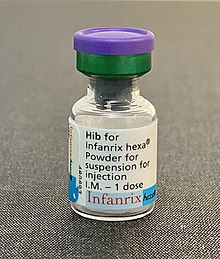 Hib component of Infanrix hexa | |
| Vaccine description | |
|---|---|
| Target | Haemophilus influenzae type b |
| Vaccine type | Conjugate |
| Clinical data | |
| Trade names | ActHIB, Hiberix, OmniHIB, others |
| AHFS/Drugs.com | Professional Drug Facts |
| MedlinePlus | a607015 |
| License data |
|
| Pregnancy category |
|
| Routes of administration | Intramuscular |
| ATC code | |
| Legal status | |
| Legal status |
|
| Identifiers | |
| DrugBank | |
| ChemSpider |
|
| UNII | |
| | |
| Identifiers | |
|---|---|
| DrugBank | |
| UNII | |
The Haemophilus influenzae type B vaccine, also known as Hib vaccine, is a vaccine used to prevent Haemophilus influenzae type b (Hib) infection.[2][3] In countries that include it as a routine vaccine, rates of severe Hib infections have decreased more than 90%.[2] It has therefore resulted in a decrease in the rate of meningitis, pneumonia, and epiglottitis.[4]
It is recommended by both the World Health Organization (WHO) and the U.S. Centers for Disease Control and Prevention (CDC).[2][5] Two or three doses should be given before six months of age.[2] In the United States a fourth dose is recommended between 12 and 15 months of age.[6] The first dose is recommended around six weeks of age with at least four weeks between doses.[2] If only two doses are used, another dose later in life is recommended.[2] It is given by injection into a muscle.[2]
Severe side effects are extremely rare.[2] About 20 to 25% of people develop pain at the site of injection while about 2% develop a fever.[2] There is no clear association with severe allergic reactions.[2] The Hib vaccine is available by itself, in combination with the diphtheria/tetanus/pertussis vaccine, and in combination with the hepatitis B vaccine, among others.[2] All Hib vaccines that are currently used are conjugate vaccine.[2]
An initial Hib vaccine consisting of plain (unconjugated) type b polysaccharide, was introduced in the United States in 1985.[7] but was replaced by a more effective conjugated formulations beginning in 1987.[8] As of 2013[update], 184 countries include it in their routine vaccinations.[2] It is on the World Health Organization's List of Essential Medicines.[9]
- ^ Professional Drug Facts
- ^ a b c d e f g h i j k l m World Health Organization (September 2013). "Haemophilus influenzae type b (Hib) Vaccination Position Paper – July 2013". Weekly Epidemiological Record. 88 (39): 413–426. hdl:10665/242126. PMID 24143842.
- ^ "WHO position on Haemophilus influenzae type b (Hib) vaccination-July 2013" (PDF). who.int. 27 October 2013. Archived (PDF) from the original on 19 January 2022. Retrieved 30 March 2016.
- ^ Mutsaerts EA, Madhi SA (2022). "11.3. Immunisation and vaccination". In Detels R, Karim QA, Baum F (eds.). Oxford Textbook of Global Public Health (7th ed.). Oxford University Press. pp. 584–589. ISBN 978-0-19-881680-5.
- ^ "Haemophilus b conjugate vaccines for prevention of Haemophilus influenzae type b disease among infants and children two months of age and older. Recommendations of the immunization practices advisory committee (ACIP)". MMWR. Recommendations and Reports. 40 (RR-1). cdc.gov: 1–7. January 1991. PMID 1899280.
- ^ "Hib (Haemophilus Influenzae Type B)". Archived from the original on 8 April 2016. Retrieved 30 March 2016.
- ^ Cochi SL, Fleming DW, Hull HF, Preblud SR, Orenstein WA (December 1986). "Haemophilus influenzae b polysaccharide vaccine. Physician acceptance and use of a new vaccine". American Journal of Diseases of Children. 140 (12): 1226–1230. doi:10.1001/archpedi.1986.02140260028019. PMID 3490784.
- ^ Weinberg GA, Granoff DM (October 1988). "Polysaccharide-protein conjugate vaccines for the prevention of Haemophilus influenzae type b disease". The Journal of Pediatrics. 113 (4): 621–631. doi:10.1016/S0022-3476(88)80369-X. PMID 3050001.
- ^ World Health Organization (2023). The selection and use of essential medicines 2023: web annex A: World Health Organization model list of essential medicines: 23rd list (2023). Geneva: World Health Organization. hdl:10665/371090. WHO/MHP/HPS/EML/2023.02.